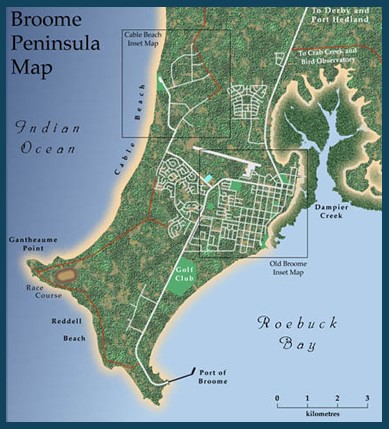Broome

Being on the North Western coast Broome has a moderate climate and the summer months provide a comfortable 33 degrees C with an all year round coastal breeze. Winter months have the average of about 27 degrees C with cooler nights. From at one time being a rough frontier town, it is now a well-heeled and busy tourist destination with reasonably good facilities.
The reefs off Broome have an excellent variety of coral, fish and invertebrate life. Diving Broome is still difficult, as the 10 m tides restrict dive times and the water can be murky. There is also the risk of box jellyfish at times and crocodiles on nearshore sites.
Broome is also the jumping off point for diving the pristine and distant Lacepedes and Rowley Shoal.
Roebuck Deeps
8-40M
The area, once an old pearl diving area, has a variety of sites. The area can be rewarding during neap tides.
Channel Rock
25M
There are a number of good dive sites around Channel Rock. It offers swim-throughs with plenty of soft corals. Fish life includes gropers and batfish. The reef is home to many small invertebrates.
Whale Rock
5-18M
This big limestone bommie lies about 1km off Gantheume Beach. It has interesting ledges with life including butterflyfish, angelfish, gropers, trevally, moray eels, wobbegongs and stingrays.
Eco-Beach
Charter operators can arrange for visits to this remote area which involves beach hut accommodation near a limestone reef covered in corals. These areas can provide good shallow diving and snorkeling during neap tides.
Swirl Rock
37M
The reef offers ledges and caves with soft corals, gorgonians, sea whips and sponges. Other marine life includes gropers, butterflyfish, and many others.
Battern Rock
35M
Battern Rock lies a stiff swim offshore and is surrounded by deep reefs. Lots of marine life including plenty of fish hang around the rock.It makes a good day or night dive.
Disaster Rock
This is a dive for encounters with larger pelagic fish, barracuda, tuna, trevally, mackerel, batfish, sharks, stingrays, eagle rays. Turtles and gropers are often hanging around the rock.
Riddell Point- Gantheume Point
10M
This is a popular snorkeling spot on patchy limestone reef near a sandy popular beach There are plenty of small reef fish to be seen as well as soft corals, sponges and anemones and other invertebrates. Sea snakes are common in the area.
Lacepedes
About 20 kms off the Dampier Peninsula and about 150 kilometres north of Broome, are four sand cays on a coral reef that make up the deserted Lacepede Islands. In 1885, sailing vessels discovered a rich source of guano, or phosphate, on the islands made from centuries of seabird droppings. The islands attracted scores of trading ships . In February 1877, 10 large sailing vessels anchored at the Lacepedes were destroyed in one of the most devastating cyclones on record. After the guano began to run out pearling luggers from further down the coast started to arrive in search of pearl shell and later used it to imprison forced Aboriginal labour. The Lacepede Islands Nature Reserve now protects the world’s largest colonies of brown boobies, the largest colonies of lesser frigatebirds in the Indian Ocean and major turtle rookeries, especially of threatened green turtles.The two larger islands, West Island 107ha, and Middle Island 54ha, have some beach rock and limestone .
Wreck of the “Manfred”
In 1879 this 611 ton barque was loading guano at the Lacepedes when a gale sprung up and she went ashore. Parts of this vessel are visible at low tide and may be easily examined as part of a snorkel around the inshore reef.
